As seasoned or even novice guitarists, understanding chord progressions is a crucial aspect of expanding our skill set.
Flamenco, a Spanish music genre, offers some of the most intricate and captivating progressions that can aid in boosting your playing techniques.
Before delving into these flamenco chord progressions, knowing about this genre’s uniqueness is pivotal.
Typically, flamenco compositions present a beautiful blend of sparkling high notes and deep resonant tones.
They offer an enriching challenge to guitarists, allowing them to unravel their potential.
With a foundation in the rich history of traditional Spanish music culture, these chord progressions are bound to spruce up your guitar playing skills.
Table of Contents
- Flamenco Chord Progressions
- I – IV – V – I (1 – 4 – 5 – 1)
- ii – V – I (2 – 5 – 1)
- iii – vi – ii – V – I (3 – 6 – 2 – 5 – 1)
- IV – V – iii – vi (4 – 5 – 3 – 6)
- i – VII – VI – V (1 – 7 – 6 – 5)
- I – bVII – bVI – V (1 – flat7 – flat6 – 5)
- ii – bII – I (2 – flat2 – 1)
- V – IV – I (5 – 4 – 1)
- vi – V – IV – V (6 – 5 – 4 – 5)
- I – bIII – IV – IV (1 – flat3 – 4 – 4)
- i – bVI – bVII – i (1 – flat6 – flat7 – 1)
- V – i – iv (5 – 1 – 4)
- i – iv – i (1 – 4 – 1)
- i – bVII – i (1 – flat7 – 1)
- I – bIII – IV – iii – ii (1 – flat3 – 4 – 3 – 2)
- The Bottom Line
Flamenco Chord Progressions
I – IV – V – I (1 – 4 – 5 – 1)
Explore the fundamental backbone of flamenco’s passionate guitar storytelling.
This I – IV – V – I (1 – 4 – 5 – 1) chord progression is a foundational sequence often used in Flamenco music due to its emotive and expressive qualities. It creates a cycle that goes from a tonal home base to a point of tension, and then brings it back to resolution, providing a dynamic, energetic, and harmonious rhythm perfect for the passionate flair of Flamenco guitar playing.
- Difficulty: Easy
- Example: C – F – G – C (Key of C)
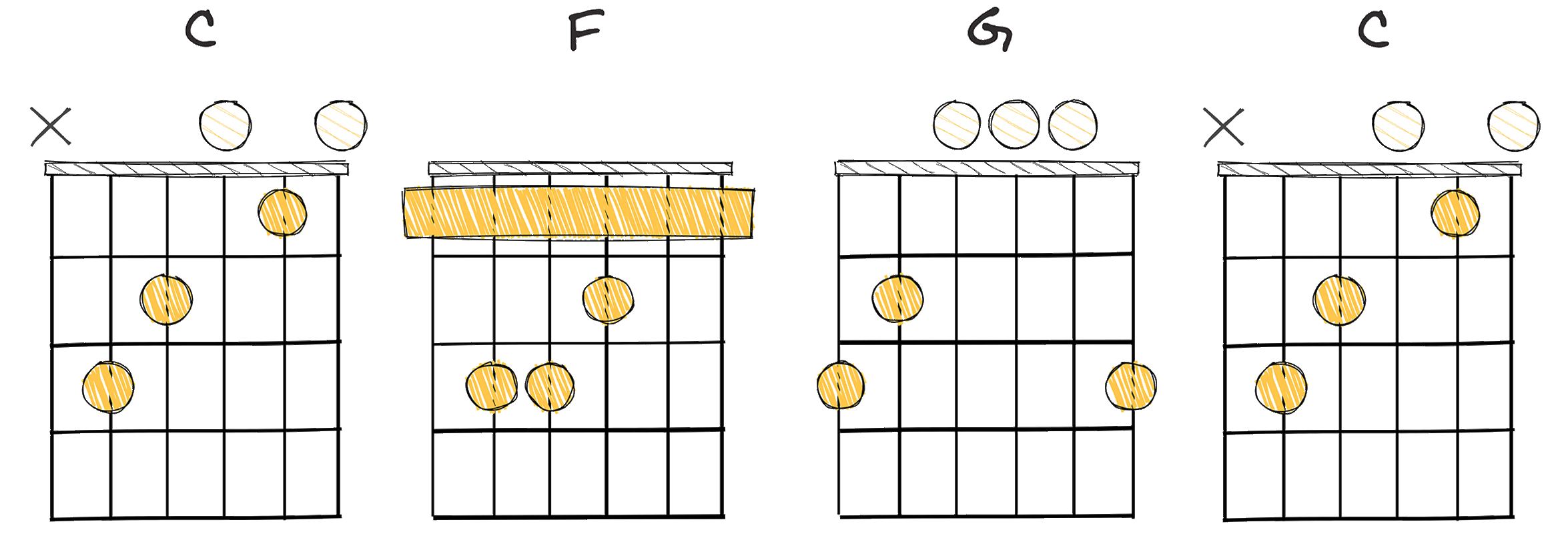
In the rich tapestry of musical and cultural tradition that spans the globe, Flamenco music enjoys a unique and revered status, and one of its most fascinating aspects is its chord progressions.
The progression I – IV – V – I, which corresponds to the chords C – F – G – C in the key of C, offers an easy yet captivating entry point into the heart of Flamenco’s melodic genius.
This progression is not merely a sequence of individual chords, but rather, they interlock and weave together in ways that create a unique rhythmic and harmonic entity.
Interestingly, this progression, I – IV – V – I, is not limited to Flamenco but finds presence in a myriad of musical genres, thus attesting to its versatility and universal appeal.
Even in the realm of classical music, this simple progression has served as a foundational bedrock.
A prime example being Pachelbel’s Canon, a baroque-period masterpiece that has captivated listeners for centuries.
However, stripped of its intricate ornamentation and transposed to a guitar, C – F – G – C can sound remarkably Flamenco-esque, transporting listeners straight to the sun-drenched streets of Andalusia with its lively, percussive strumming patterns.
The rich cultural history of Flamenco music, rooted as it is in the Andalusian region of Spain, has left a profound imprint on this progression’s characteristically Spanish musical flavor.
Even the geographical origin of Flamenco helps to explain the intrinsic connection between its chord progressions and its sorrowful, longing, and passionate tone, as people of these regions have historically experienced great emotional upheaval.
The I – IV – V – I progression also has an easy-to-understand structure and can be played without much complexity.
It’s simplicity allows novice guitarists to experiment and improvise with the Flamenco style without getting overwhelmed by the intricate finger-work that the genre is often known for.
Simplicity notwithstanding, for those willing to delve deeper, this progression holds enough complexity and subtlety to keep even the most accomplished players engaged, thus making it a favorite of both beginners and seasoned musicians alike.
Its simplicity is its strength; the I – IV – V – I progression is easy to understand and easy to play, which makes it approachable and widely .
Whether you’re a new guitar player or an experienced musician, the I – IV – V – I progression is a wonderful introduction to the world of Flamenco music.
By mastering this fiery and lush musical tradition, you can add a new flavor to your playing, expand your musical vocabulary, and connect with a rhythmic and melodic tradition that has been loved and celebrated for centuries.
ii – V – I (2 – 5 – 1)
Explore the melodious journey of the iconic Flamenco ii-V-I progression.
The ii-V-I progression is a fundamental sequence in flamenco music, predominantly played on the guitar. It involves the transition from the supertonic to the dominant, finally resolving on the tonic, providing a soulful and rhythmic backbone to this passionate genre.
- Difficulty: Intermediate
- Example: Dm – G – C (Key of C)
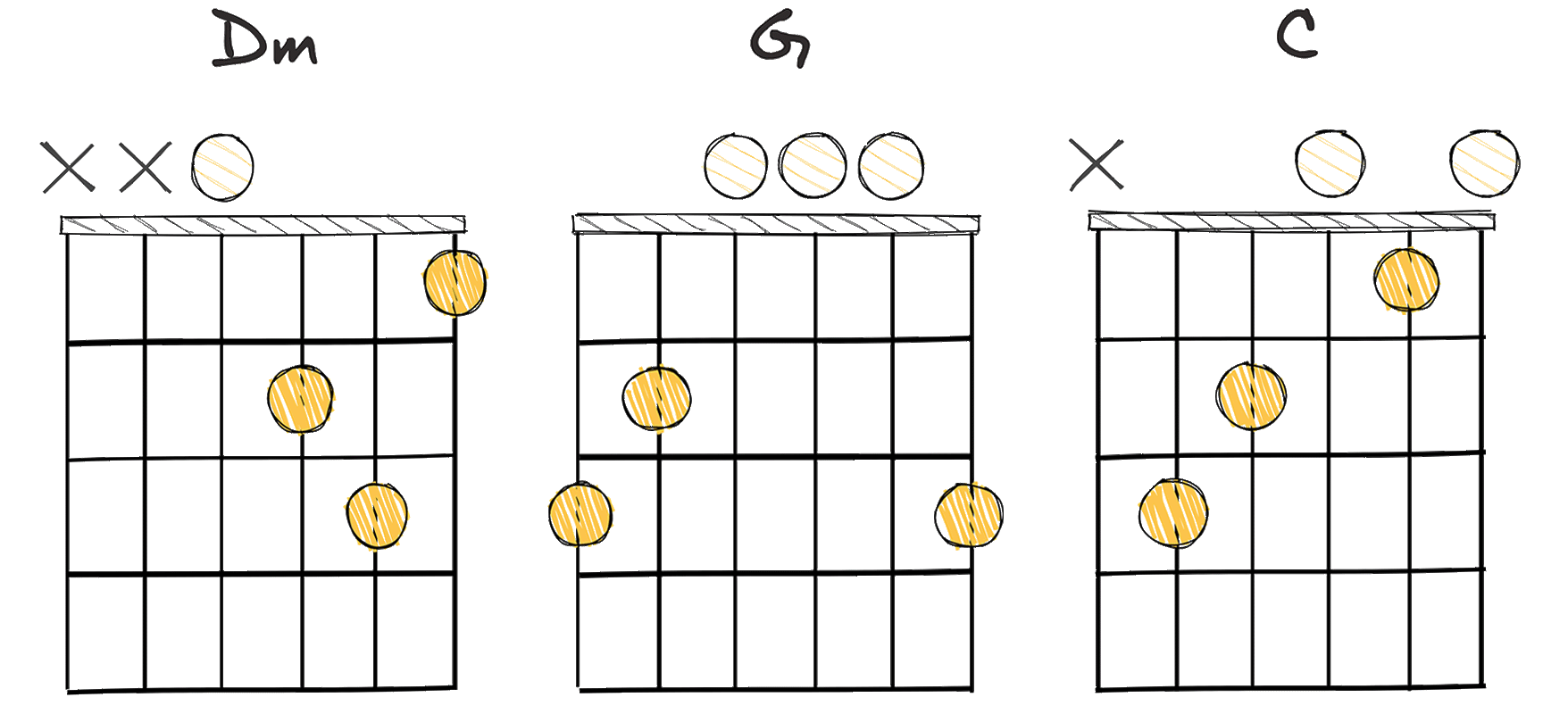
One of the most versatile chord progressions that can greatly enhance your skills as a guitarist is the ii – V – I (2-5-1) progression.
As an aspiring Flamenco guitarist, mastering the ii – V – I progression should be one of your top priorities.
It’s a fundamental chord progression that is quintessential in several musical styles, especially in Flamenco.
This value in Flamenco music is due to the beautiful tension it creates and resolves, mirroring the passionate and intense nature of this music genre.
Furthermore, this progression has been a beloved element of Flamenco music for centuries, making it a core part of the music genre’s history and influence.
Additionally, the ii – V – I progression in the key of C, D minor (ii), G (V), and C(I), provides an excellent foundation for Flamenco players to experiment with various fingerpicking patterns and strumming techniques.
This progression is intermediate in terms of difficulty, making it an excellent choice for more experienced beginner Flamenco guitarists who are ready to tackle more complex chord changes.
From an instructional standpoint, it is recommended to practice this progression “slow and steady,” using metronome training to build speed.”
This technique not only helps to maintain accurate timing, but also incorporates the key Flamenco element of rhythmic adherence.
Moreover, it’s important to note that the ii – V – I progression finds its roots not only in Flamenco but also in jazz, where it’s often utilized in numerous compositions and improvisations.
In Flamenco, this common jazz progression is often combined with Flamenco’s characteristic tonalities like the Phrygian dominant (also known as the Flamenco mode), producing an exciting fusion of styles and harmonies.
Furthermore, practicing the ii – V – I progression can be an enlightening experience for guitarists of all levels, as it can expose you to music theory concepts like voice leading and chord substitution.
iii – vi – ii – V – I (3 – 6 – 2 – 5 – 1)
Experience classic flamenco tension and resolution in this irresistible progression.
This progression, iii – vi – ii – V – I, is a classic sequence used frequently in flamenco music, contributing significantly to the genre’s distinctive sound. It creates a vibrant and energetic musical journey, making it a must-try for any guitar player seeking to explore the richness of Flamenco’s chord progressions.
- Difficulty: Intermediate
- Example: Em – Am – Dm – G – C (Key of C)

The iii – vi – ii – V – I chord progression (3 – 6 – 2 – 5 – 1) is a pivotal element in the flamenco guitar tradition.
Historically, this progression has been a critical root of flamenco music, characterized by its passionate and rhythmic sounds.
While it might initially seem somewhat challenging, this intermediate level progression is especially compelling to the keen and enthusiastic guitar player.
This particular sequence comes alive under the practiced hands of experienced flamenco guitarists, illuminating the unique tone and aesthetic of this distinct music genre.
This chord progression has a way of capturing the passionate emotion that is so distinctive of flamenco music, while demonstrating the technical prowess Flamenco guitar playing requires.
The complexity of the flamenco style necessitates a keen understanding and implementation of a myriad of chord progressions, this one being no exception.
Its foundation is embedded in the traditional music of Andalusia, a region in southern Spain, which is known as the heartland of flamenco music.
Even present-day flamenco players continue to utilize these traditional progressions, highlighting the authenticity inherent in the history of this genre.
By working through this progression, players are taken on a journey that explores the very essence of the emotional language embedded in flamenco music.
By integrating these progressions into your repertoire, you’ll enhance your understanding of the flamenco style and expand your overall musical vocabulary.
This progression is particularly enjoyable to play, with its engaging rhythmic structure and intricate finger-plucking technique adding to its appeal.
Significantly, this progression offers a world of opportunities for the guitar player eager to delve into the depth and richness of flamenco music.
Through this complex yet rewarding chord progression, guitar players are offered a chance to enhance their technique, flair, and understanding of this compelling genre.
IV – V – iii – vi (4 – 5 – 3 – 6)
A passionate flamenco progression that evokes a sense of longing.
The IV – V – iii – vi chord progression introduces an exotic flair characteristic of flamenco music, challenging typical guitar techniques. The transitioning from the subdominant (IV) to the dominant (V), and then resolving to the mediant (iii) and submediant (vi) draws on the classic pull and release tension that flamenco style thrives in.
- Difficulty: Intermediate
- Example: F – G – Em – Am (Key of C)
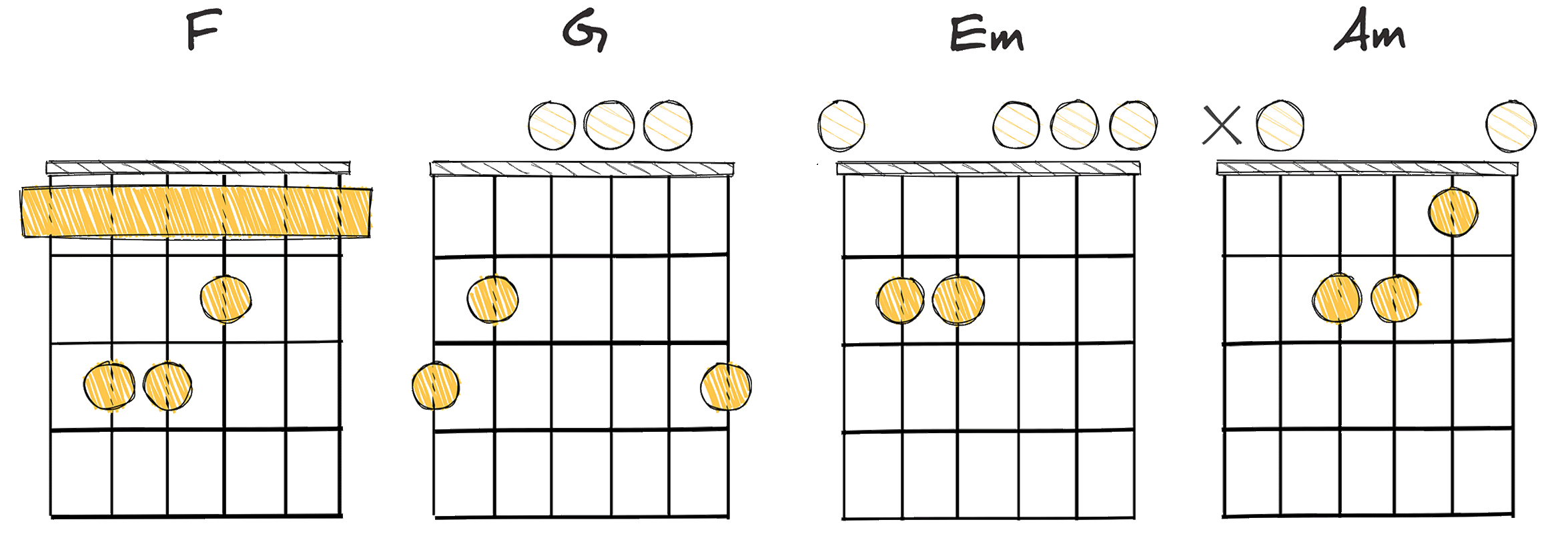
The fascinating world of Flamenco chord progressions offers many unique layers to guitarists.
One particularly interesting progression to examine is the IV – V – iii – vi sequence, equivalent to F – G – Em – Am in the Key of C.
When a guitarist ventures into the realm of Flamenco, this progression provides a solid, melodic foundation.
Its intermediate complexity makes it a great step for players eager to explore beyond basic chord progressions.
While not traditionally associated with Flamenco, the incorporation of this sequence has enriched the genre and added a touch of unpredictability to compositions.
This progression carries an indelible stamp of drama and tension, making it a powerful tool for Flamenco guitarists.
Surely, the emotional intensity conveyed through this progression matches perfectly with Flamenco music, known for its passionate and stirring nature.
Not only does it add a certain flair to the performance, but it also creates a satisfying tension-and-release dynamic that is integral to the Flamenco style.
The IV – V – iii – vi progression has a rich history within a wide range of musical genres, spanning from classical to modern music.
i – VII – VI – V (1 – 7 – 6 – 5)
Explore vibrant, emotional depth with this Flamenco chord progression.
This Flamenco chord progression, i – VII – VI – V, originates from Spanish music and creates a distinctively passionate and intense sound. The unique shift from the root chord to the flatted seventh and sixth, ending on the fifth, generates a dramatic and exciting musical atmosphere, making it a must-try for guitar players exploring different genres and styles.
- Difficulty: Intermediate
- Example: Am – G – F – E (Key of A minor)
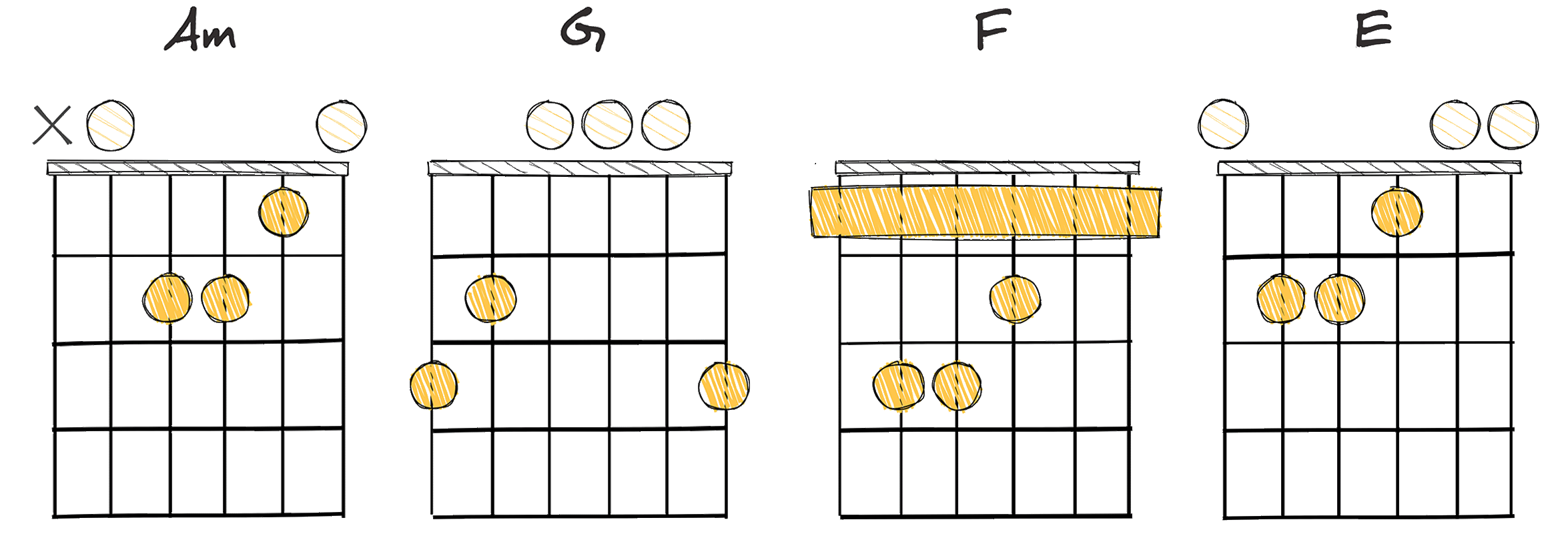
The flamenco chord progression i – VII – VI – V (1 – 7 – 6 – 5) crafts a mesmerizing blend of sounds and feelings, certain to enthrall listeners on a spellbinding musical voyage.
This progression, expressed numerically as 1 – 7 – 6 – 5, is inherently connected with the gripping and emotional performances that are the hallmark of Flamenco music.
The profound historical connection of Flamenco infuses this progression with an added layer of intrigue for guitar aficionados, linking the delicate fingerings and vibrant strums to a colorful mosaic of age-old Spanish melodies.
Venturing into the world of this progression can whisk the listener away to the lively streets of Granada, where dancers and musicians ignite the air with intense performances, all to the rhythmic sway of Flamenco chords.
The progression i – VII – VI – V melds minor and major chords in a sequence that crafts an impeccable harmony of excitement, tension, and release, reflecting Flamenco’s narrative essence.
For a Flamenco guitarist, engaging with this progression is like an intimate dialogue with the instrument, narrating tales of desire, joy, and sometimes, melancholy, one poignant chord after another.
The chord progression Am – G – F – E in the key of A minor is a quintessential example of this progression, utilizing a harmonious blend of open and barre chords.
The exploration and mastery of this chord progression can be an exhilarating and fulfilling adventure for a guitarist, particularly those drawn to the allure of Flamenco.
However, it’s essential to recognize that the subtleties and rhythmic intricacies of Flamenco guitar demand a certain degree of expertise.
This makes the Flamenco progressions like i – VII – VI – V more suitable for intermediate players who have a solid grasp of both major and minor chords.
The journey of learning and perfecting this chord progression is filled with challenges and triumphs, much like the emotional rollercoaster conveyed through Flamenco’s distinct chord sequences.
Consistency and practice remain the cornerstones of unlocking the fervor and enthralling sensations that are at the core of Flamenco’s unparalleled chord progressions.
Therefore, any guitarist with aspirations of delving into this genre should undoubtedly embrace this essential Flamenco chord progression, as it’s a gateway to the rich and complex world of Spanish musical tradition.
I – bVII – bVI – V (1 – flat7 – flat6 – 5)
Conjures an exotic melody, blending tension and resolution to echo the passionate soul of flamenco.
The I – bVII – bVI – V progression in G major, with its chords G – F – E♭ – D, emits an exotic and captivating sound. Its unique combination of major and flattened chords weaves a musical tapestry filled with tension and resolution, offering an entrancing melody that echoes the passionate soul of flamenco.
- Difficulty: Intermediate
- Example: G – F – Eb – D (Key of G)
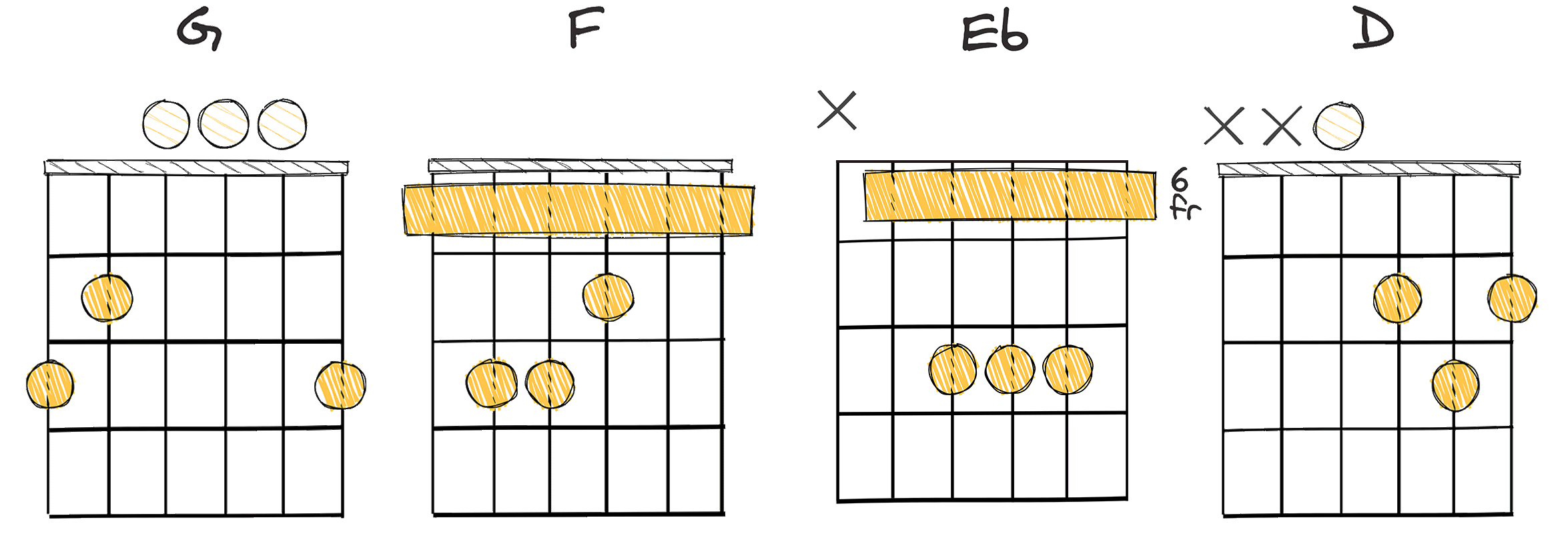
The I – bVII – bVI – V (1 – flat7 – flat6 – 5) chord progression is a tantalizing pattern that resonates in various genres, especially in flamenco music.
These chord patterns have roots in the rich musical traditions of Andalusia and are often associated with the enigmatic quality of flamenco performances.
The progression plays a pivotal role in setting the mood and emotional intensity of a musical piece, mirroring the passion inherent in flamenco.
Although it might not be as commonly referred to by a specific name like the ’50s progression, its influence in flamenco is unmistakable.
This I – bVII – bVI – V progression adds a touch of exoticism and intrigue, making it a beloved choice among composers and guitarists who explore flamenco’s various palos (styles).
The complexity of this particular sequence adds depth and character while preserving a mesmerizing melody that captures the essence of flamenco.
This flamenco chord progression is regarded as intermediate in terms of difficulty but offers a rich tapestry of sound.
It demands a keen understanding of both major chords and flattened chords, requiring graceful transitions between them.
The G – F – Eb – D chord sequence in the Key of G major is an exemplar of this flamenco progression.
Each chord in this sequence necessitates distinctive finger placements that contribute to the progression’s unique and authentic flamenco resonance.
As enthralling as dissecting the structure and origins of this progression may be, its real allure lies in its application in real-world flamenco compositions.
Experimentation with these chords can open doors to new horizons in your flamenco guitar playing, fostering creativity and a fresh approach to well-loved classics.
ii – bII – I (2 – flat2 – 1)
A rhythmic flamenco journey from tension to unexpected, exotic resolution.
This particular ii – bII – I chord progression is widely used in Flamenco music, providing a traditional, distinctive sound often associated with Spanish guitar. The movement from the supertonic minor to a flattened supertonic, before resolving to the tonic, creates a dramatic and intense feel which is characteristic of flamenco’s passionate nature.
- Difficulty: Intermediate
- Example: Dm – Db – C (Key of C)
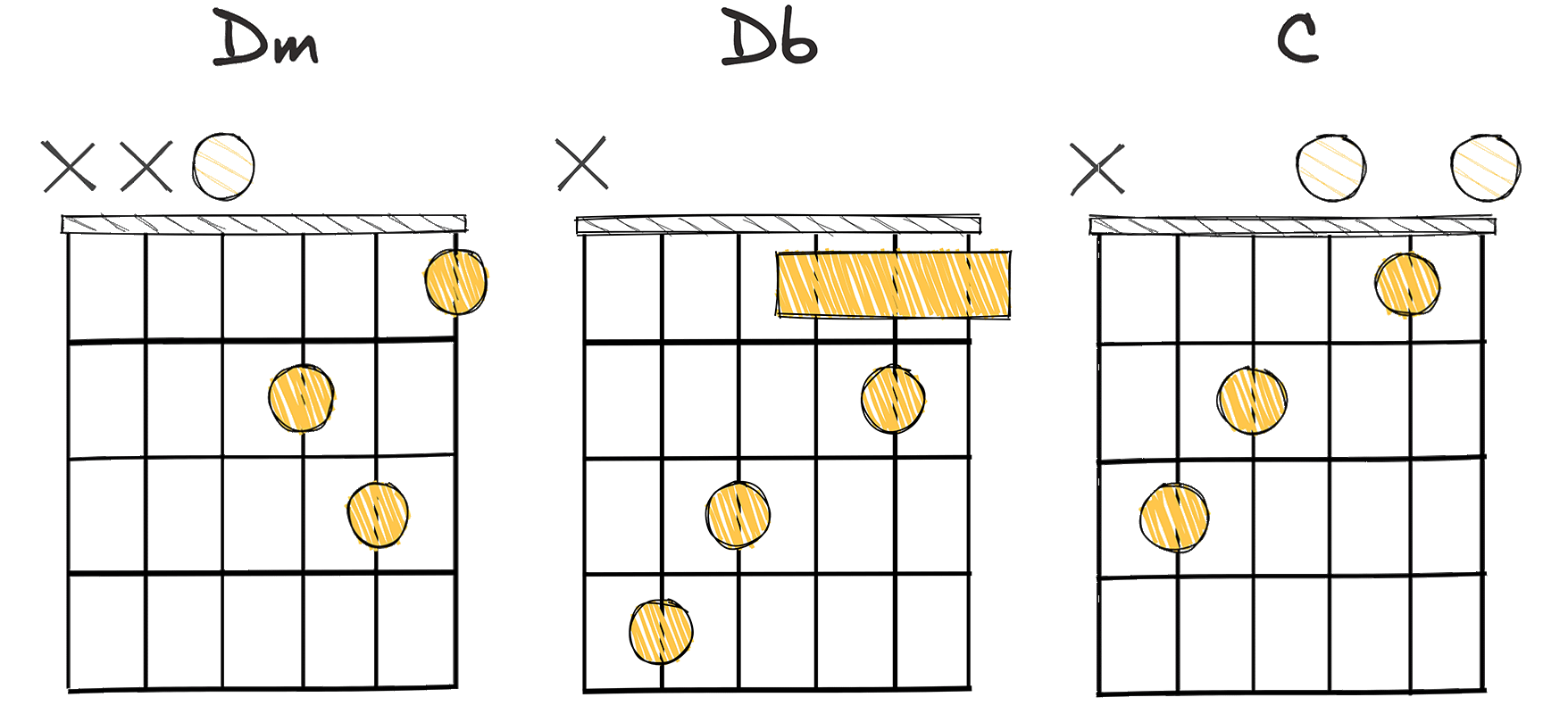
When we talk about Flamenco chord progressions, one which particularly stands out and also serves as an inspiring starting point for many guitarists, is the ii – bII – I progression in the key of C, which converts to Dm – Db – C when applied.
This Flamenco progression is intermediate to play yet it carries a poignant depth of the flamenco musicality.
Historically, Flamenco music originated from the Andalusian region in southern Spain, a region richly steeped in a culture that combines influences from the native Andalusians, Romani, Moors, Sephardic Jews, and Gitanos (Spanish Gypsies).
The ii – bII – I progression is a testament to this rich cultural tapestry, as it embodies the exotic, yet melancholy sound which is often associated with this historic music genre.
Moreover, the specific progression, ii – bII – I, also known as the neo-Andalusian cadence, finds usage beyond the realms of Flamenco music, extending its influence into genres ranging from rock and pop to jazz and even classical music.
This extensive use across different genres is a testament to the versatility and universal appeal of the ii – bII – I progression.
Artists from all over the world find themselves drawn to its haunting and evocative soundscape, primarily using it to introduce a distinct flavor of Flamenco essence into their sonic creations.
It’s important to note that playing the ii – bII – I progression involves more complex aspects such as mastering the Flamenco style right-hand fingerpicking techniques and percussive rhythm elements known as golpe.
So, it requires a certain level of guitar proficiency..
However, don’t be dissuaded as the journey learning to perform this progression effectively can prove to be deeply rewarding.
As well as demonstrating your technique, the ii – bII – I progression also demonstrates your understanding of theory – a valuable tool for any musician.
When learning this progression, start slowly.
Emphasize clean notes and seamless transitions between chords.
Once you’ve got these basics down, you can then begin to introduce the distinctive strumming and picking patterns that typify Flamenco music.
Remember, practice makes perfect.
The more you create space for this progression in your practice routine, the more naturally it will come when you’re improvising or composing.
Even though this chord progression originated from a specific regional culture and music style, the ii – bII – I progression has found its place in the wider world of music.
Therefore, learning it doesn’t just improve your range as a guitar player; it also improves your understanding and appreciation of global music structures.
Exploring this progression will take you on a rich and rewarding musical journey that may even influence how you write, play, and appreciate music.
V – IV – I (5 – 4 – 1)
Experience the authentic pulse of Flamenco with this exotic progression.
The V – IV – I (5 – 4 – 1) progression is a primary chord progression used in many flamenco songs, giving it a distinctive sound. This musical sequence can create a powerful, dramatic, and emotional effect, making it a must-know for any guitar player interested in flamenco style.
- Difficulty: Intermediate
- Example: G – F – C (Key of C)
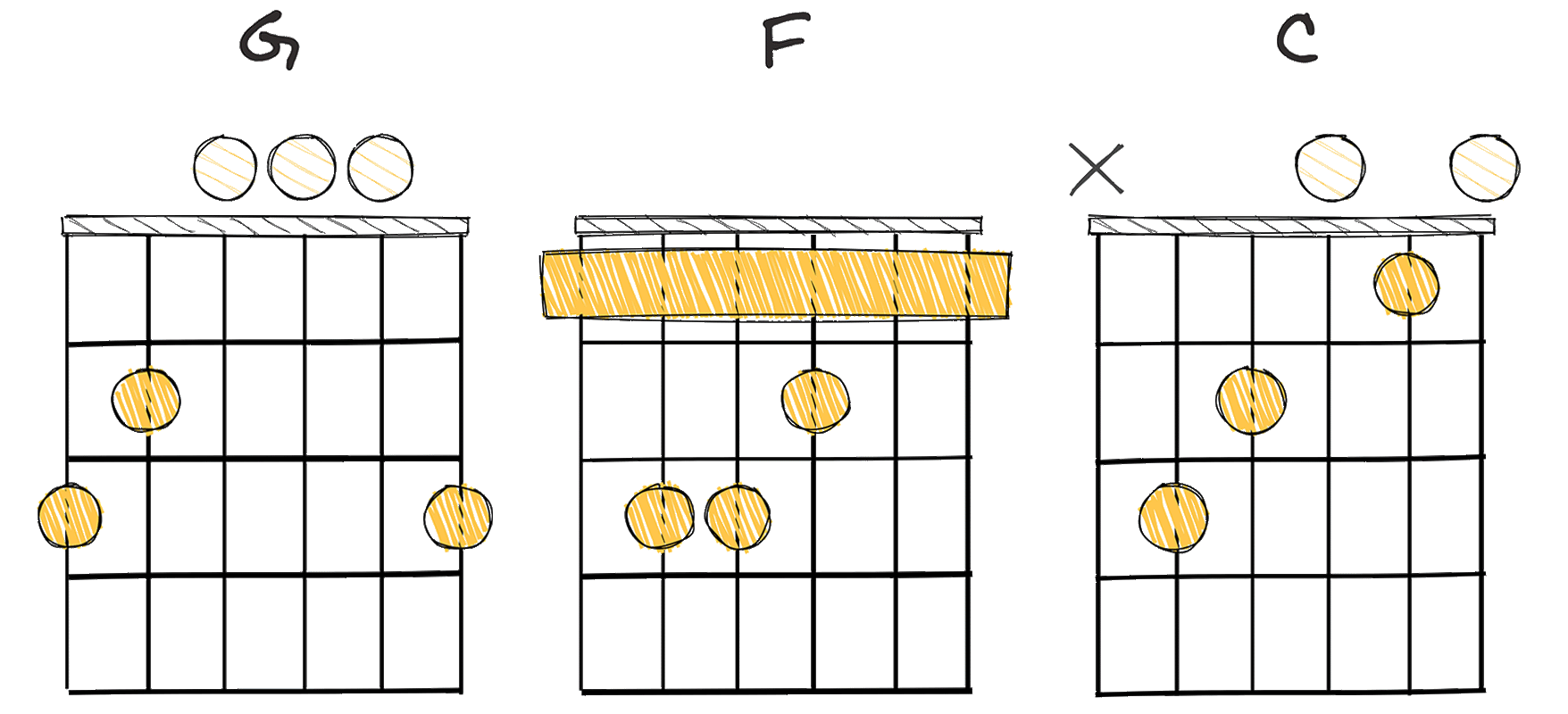
The V – IV – I (5 – 4 – 1) chord progression, in the context of flamenco music, is a unique sequence that captures the evocative and richly textured sound of this Spanish genre on the guitar.
Traditionally, this sequence is represented as G – F – C in the Key of C.
Originating from the cultural melting pot of Andalusia in southern Spain, flamenco music is known for its deeply emotional and passionate qualities.
The V – IV – I chord progression contributes to this distinctive sound and emotion.
The V – IV – I progression is of intermediate difficulty, remaining accessible for guitarists at this level while still providing a challenge to master the rhythmic precision and rapid finger work required in flamenco style.
The progression begins on the dominant (V), moves to the subdominant (IV), and resolves on the tonic (I).
This creates a strong feeling of ‘homecoming’, as the music returns to its fundamental note or ‘home’ chord.
One of the special things about this chord sequence is that it is downward movement, going from the V to the IV and then to the I, which contrasts with many other popular progressions that often move upward.
Typically, the V – IV – I progression unveils a textured musical narrative appropriate for the storytelling element inherent in flamenco music.
Supporting this point, the interplay of major and minor chords in the V – IV – I progression mirrors the push-and-pull dynamic of flamenco, with its intermingling of joyous and sorrowful themes.
The versatility of this chord progression is further evidenced in its adoption across various music styles.
It can be heard in other genres outside of flamenco, such as blues, rock, and pop.
Yet, within flamenco music, the V – IV – I progression resonates with an authentic sevillanas flavor, a popular flamenco style that evokes the folkloric dances of Seville.
The emotional impact of this progression, however, cannot be fully appreciated without understanding its cultural and historical context.
Flamenco itself is an expression of the fiercely independent and passionate Andalusian spirit, often eloquenced through deep, heartfelt singing, rhythmic clapping, and of course, expressive guitar playing.
As an aspiring flamenco guitarist, experimenting with this sequence can unlock new shades of emotion in your playing and further deepen your understanding of this complex and dramatic art form.
Embracing the challenges presented by the V – IV – I progression – including mastering the flamenco strumming patterns, building up speed and precision, and integrating the complex emotions of the music – will undoubtedly enhance your musical abilities and breed greater fluency in flamenco’s rich language of chords.
Take the plunge and explore the creative possibilities inherent in this fascinating chord progression, at the heart of Spanish flamenco guitar.
vi – V – IV – V (6 – 5 – 4 – 5)
A flamenco touch to your guitar play with a twist.
The vi – V – IV – V progression in C major (A minor – G major – F major – G major) provides a gentle yet dynamic sound. The minor start adds a touch of melancholy, which is then lifted by the major chords, creating a wave-like ebb and flow that’s both reflective and inspiring.
- Difficulty: Intermediate
- Example: Am – G – F – G (Key of C)
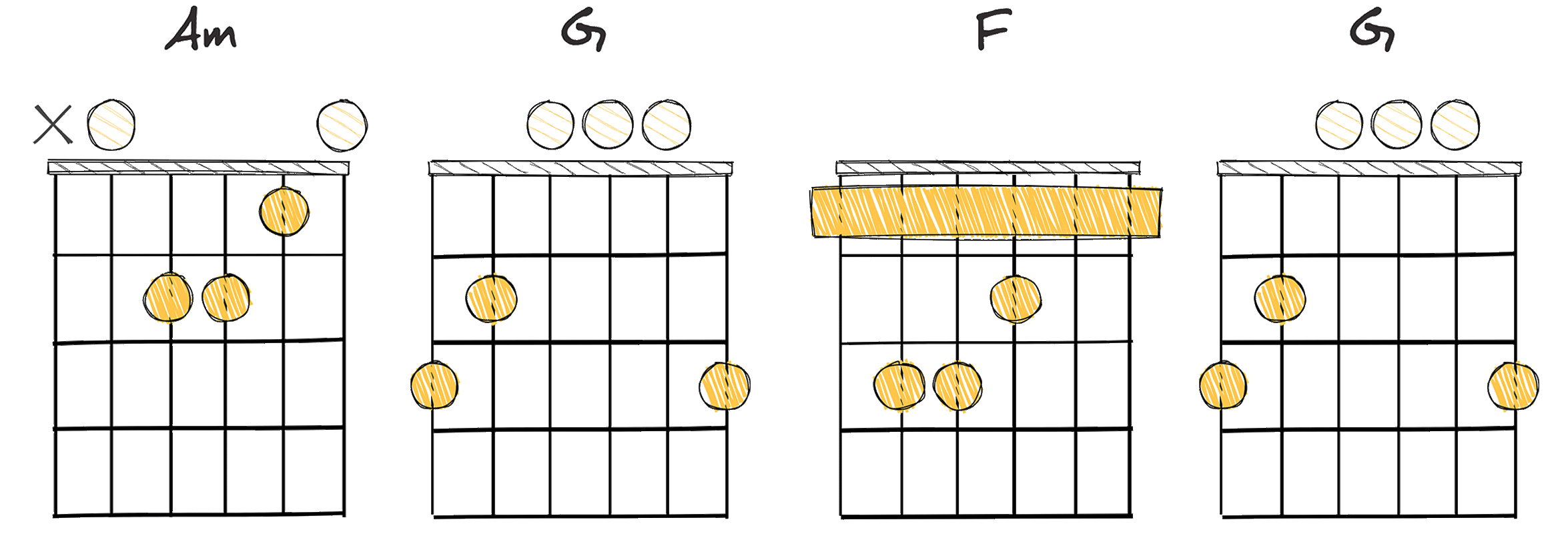
The flamenco chord progression referred to as vi – V – IV – V (6 – 5 – 4 – 5), or Am – G – F – G in the key of C is an intermediate-level progression that carries a unique and distinctly Spanish tonality.
This chord progression, like many others used in flamenco music, is deeply rooted in the Moorish influences present in the Andalusian region of Spain, where flamenco originated.
As a guitar player delving into flamenco music, understanding this progression can provide an authentic and engaging approach to the genre.
Flamenco music uniquely intertwines rhythm, melody and harmony, giving it a distinct signature and the chord progression vi – V – IV – V (6 – 5 – 4 – 5) is a prominent example of this.
The quoted assertion above highlights the inherent rhythmic, melodic, and harmonic intricacies found in flamenco music generally and this chord progression specifically.
It’s worth pointing out that the character of this progression, marked by swift, decisive movements between the vi, V, and IV chords and back to the v chord, captures the passionate and emotive essence flamenco is renowned for.
On a technical level, executing this progression requires the ability to swiftly and smoothly transition between chords while maintaining the rhythm essential to flamenco music.
Successfully mastering this progression requires rhythmic precision and confidence, as flamenco music is particularly rhythm-driven, with a tendency towards intricate strumming patterns and percussive techniques.
Though this progression is intermediate in terms of difficulty, its mastery opens up fertile grounds for creative exploration within the flamenco genre.
The mesmerizing quality of this particular chord progression creates a robust platform to experiment with flamenco’s signature techniques such as rasgueado, alzapua, picado, and golpe.
Clearly, the chord progression vi – V – IV – V (6 – 5 – 4 – 5) offers a launching point into the vibrant world of flamenco music, providing an invaluable opportunity for any intermediate guitarist looking to enhance their musical repertoire.
I – bIII – IV – IV (1 – flat3 – 4 – 4)
An emotionally resonant sequence, adds Spanish touch to your performance.
This unique chord progression typically found in flamenco music deviates from traditional western music theory, blending major and minor tonalities to create a distinct character. Starting with the root note “I”, it moves to a lowered third “bIII”, a major fourth “IV”, before resolving with the fourth “IV”, providing a hauntingly beautiful and melodically compelling sound that’s deeply intriguing to most guitarists.
- Difficulty: Intermediate
- Example: C – Eb – F – F (Key of C)
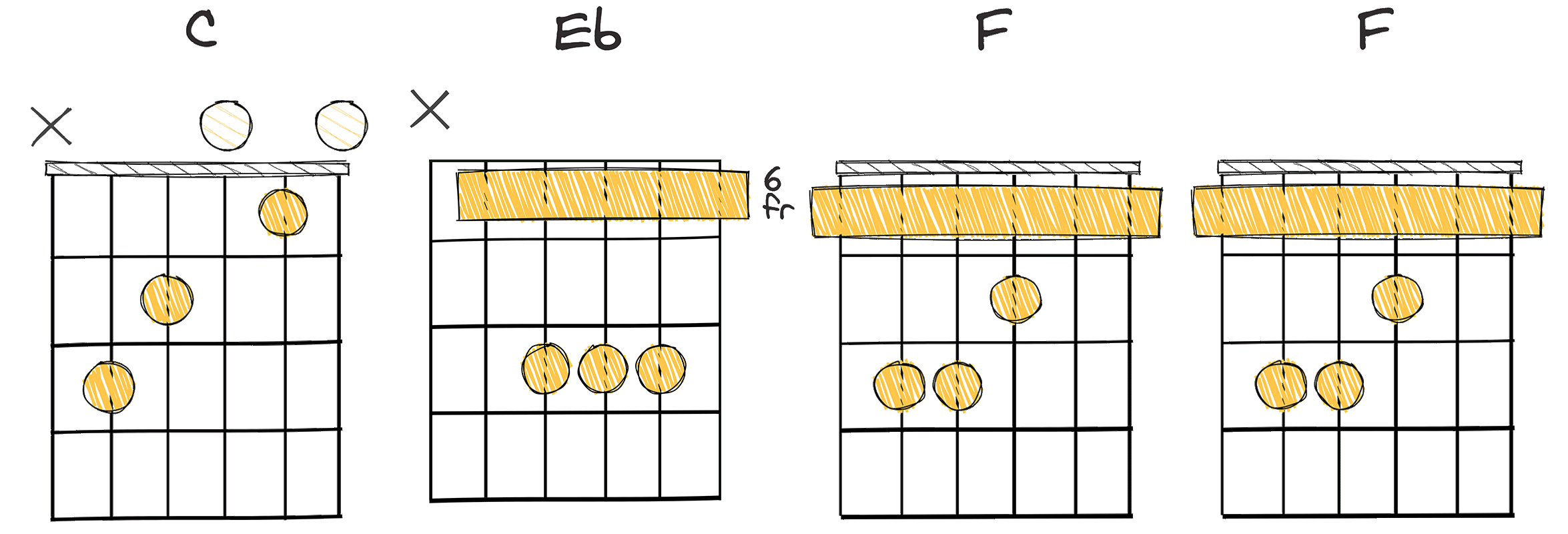
The chord progression of I – bIII – IV – IV (1 – flat3 – 4 – 4), when viewed on the surface, appears simple, but it has a depth that has tantalized Flamenco guitar players for generations.
The structure of this sequence bridges the gap between melancholy and jubilation, found within the tonal shifts of the progression.
Rooted predominantly in the major key, this progression commences with the I chord, which establishes a foundation of sobriety and solemnness.
The subsequent shift to the bIII chord allows for an unexpected breath of freshness, injecting a liveliness into the sober foundation provided by the i chord.
The transition from the minor i chord to the major bIII chord lies at the nucleus of the progression’s allure, providing a surprising yet pleasant tonal shift that is one of the hallmarks of Flamenco music.
This startling transition gives the progression its distinct Flamenco feel and provides a canvas for the guitarist to explore and play with a variety of tonal colors.
The bIII chord, in its majesty, rings true to the dynamic nature of Flamenco music, unfurling an enriching contrast between the minor i and the major IV chords, amplifying the progression’s overall impact.
Our journey through this chord progression brings us to the IV chord.
A major chord, it provides a brief respite from the emotional turmoil incited by the interaction between the minor i and major bIII chords.
Yet, the progression does not let us stay in this comfort zone for long.
A sudden sweep to the iv chord pulls us back into a state of tension and sadness, seasoned with a tinge of introspection – a characteristic fundamental to Flamenco music.
Historically, this Flamenco chord progression took shape amid the intricate political and socio-cultural contours of Andalusian society in Southern Spain.
Flamenco, a traditional form of Spanish music, is noted for its intense and deep expressiveness, which is reflected especially in this progression.
Many celebrated guitarists have leveraged the emotionally evocative power of this chord progression over the years.
Speaking of famous examples, the legendary composition ‘Asturias’ by Isaac Albéniz springs to mind.
Although originally composed for piano, its guitar adaptation makes wonderful use of this chord progression, portraying the intensities and nuances it is capable of kindling.
In the context of Flamenco guitar, the I – bIII – IV – IV brings an intermediate challenge to the guitarist, integrating the need for accurate finger placement, efficient chord transitions, and emotional understanding.
The key to mastering this progression lies in developing a keen sensitivity to the emotional narratives that these chords weave and in how these narratives can be enhanced through various Flamenco guitar techniques.
As we continue to delve into other Flamenco chord progressions, let’s keep exploring the vast emotive landscapes that these progressions enable us to traverse on our Flamenco guitars.
i – bVI – bVII – i (1 – flat6 – flat7 – 1)
Exotic progression infusing your guitar with passionate Flamenco vibes.
This unique chord progression in Flamenco music, known as i – bVI – bVII – i, or 1 – flat6 – flat7 – 1, adds drama and tension to the music. Perfect for creating a suspenseful atmosphere, this progression is a wonderful mechanism for guitar players interested in exploring diverse musical styles and moods.
- Difficulty: Intermediate
- Example: Am – F – G – Am (Key of Am)
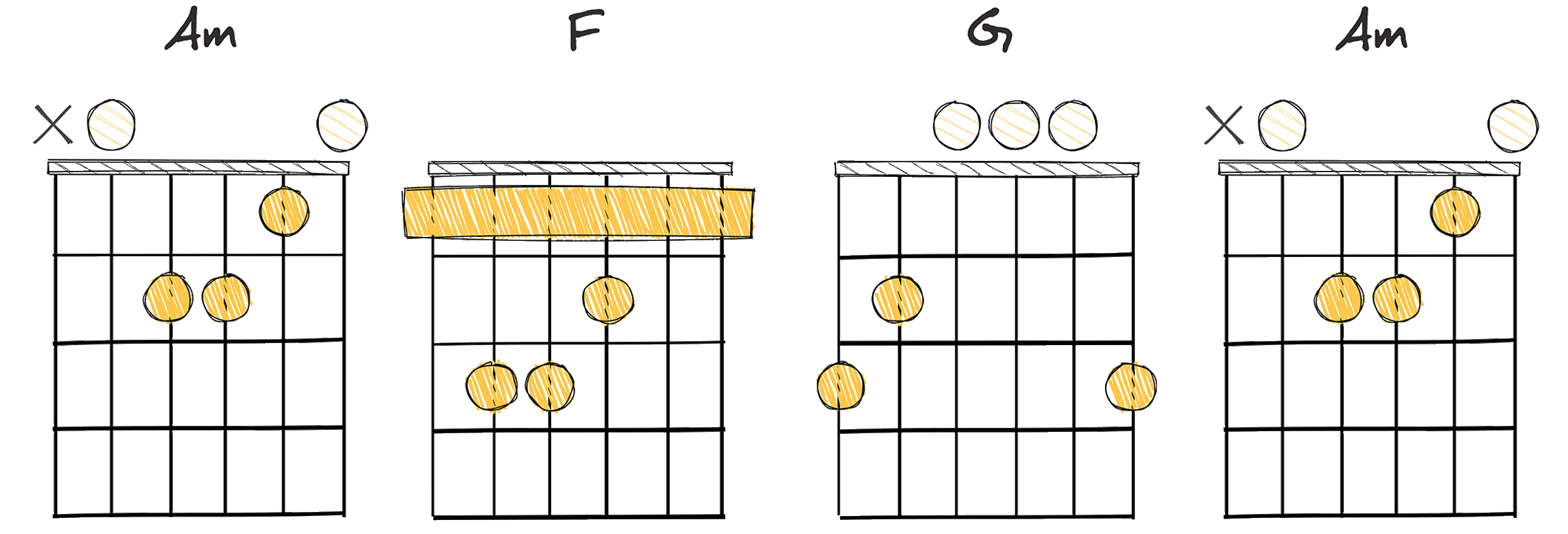
The chord progression of i – bVI – bVII – i, or in the key of A minor, Am – F – G – Am, is an Intermediate chord progression that any guitarist looking to delve into different styles, specifically flamenco, should try out.
This progression, like the flamenco style it is part of, has a rich history steeped in the music of Spain and its diverse cultural influences.
Flamenco is deeply rooted in the Andalusian region in southern Spain, and the corresponding chord progression is reminiscent of this rich cultural background
This region has a deep history steeped in myriad influences, from North African, Gypsy, Jewish, to Christian cultures.
It’s only natural that flamenco, and the chord progressions used in it, are reflective of this cultural melting pot.
In flamenco music, the i – bVI – bVII – i progression holds a special place.
The progression’s dramatic tension and emotional richness make it a staple in many flamenco compositions.
The progression is intermediate to play, and it stands out among other common progressions due to its unique tonal properties that are characteristically flamenco.
The i – bVI – bVII – i progression, as used in flamenco, often employs ‘Phrygian mode’, which adds an extra layer of complexity.
The Phrygian mode, also known as the Spanish Gypsy scale, is a musical mode that originated in ancient Greece and found its way into flamenco via Moorish influences.
The inclusion of this mode in the chord progression adds to the mystery, depth and allure of flamenco music.
Over the years, many songs within and outside the flamenco genre have used this chord progression to stunning effect.
Learning this progression would therefore be a worthwhile venture for any flamenco guitar aspirant.
In conclusion, the exploration and practice of the i – bVI – bVII – i chord progression can significantly enrich a guitarist’s flamenco repertoire.
V – i – iv (5 – 1 – 4)
A captivating journey through evocative Spanish tonalities and tension.
The progression V – i – iv (5 – 1 – 4) in Flamenco music exudes a magnetic allure, weaving a melody that’s both haunting and invigorating. It creates a dance of tension and release, where chords resonate with an emotional depth, echoing the soulful cries and passionate heart of traditional Spanish culture.
- Difficulty: Intermediate
- Example: E – Am – Dm (Key of A minor)
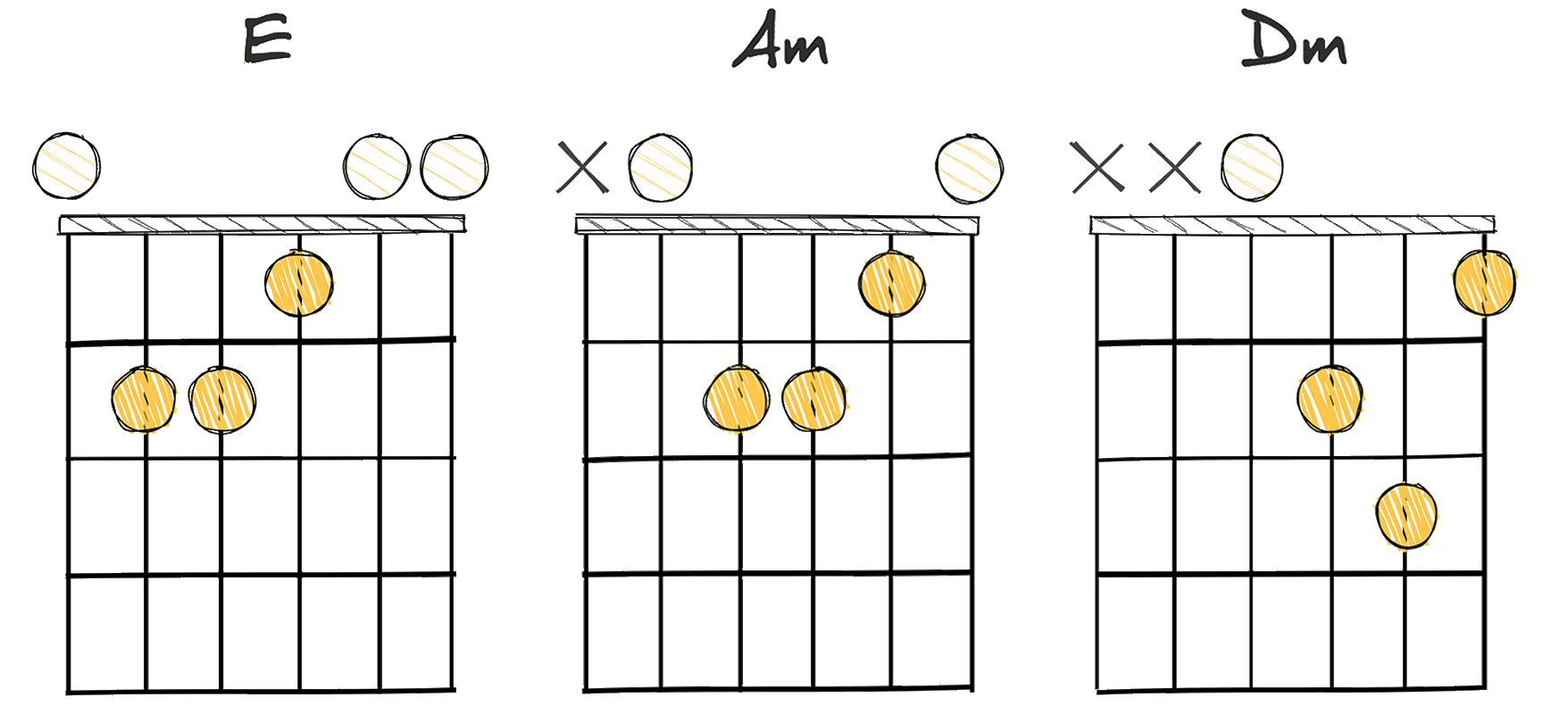
The flamenco chord progression V – i – iv (5 – 1 – 4) weaves an equally mesmerizing tapestry of sounds, taking listeners on an evocative musical odyssey that resonates with the soul of traditional Spanish music.
This progression, numerically represented as 5 – 1 – 4, is a vital component in the expressive and passionate performances that define Flamenco music.
The historical connection of Flamenco with this progression adds an extra layer of intrigue for guitar enthusiasts, linking the delicate fingerwork and resonant strums to the vibrant and timeless sounds of Spanish culture.
Embarking on the path of this progression can lead the listener to the heart of Seville, where dancers and musicians ignite the stage with fiery performances, all to the rhythmic pulse of Flamenco chords.
The progression V – i – iv melds major and minor chords in a sequence that crafts an impeccable harmony of suspense, tension, and resolution, mirroring Flamenco’s narrative essence.
For a Flamenco guitarist, engaging with this progression is like a profound dialogue with the instrument, narrating tales of desire, romance, and sometimes, sorrow, one resonant chord after another.
The chord progression E – Am – Dm in the key of A minor is a prime example of this progression, utilizing a combination of open and barre chords.
The exploration and mastery of this chord progression can be an exhilarating and fulfilling adventure for a guitarist, particularly those drawn to the allure of Flamenco.
However, it’s essential to recognize that the subtleties and rhythmic intricacies of Flamenco guitar demand a certain degree of expertise.
This makes the Flamenco progressions like V – i – iv more suitable for intermediate players who have a solid grasp of both major and minor chords.
The journey of learning and perfecting this chord progression is filled with challenges and triumphs, much like the emotional rollercoaster conveyed through Flamenco’s distinct chord sequences.
Consistency and practice remain the cornerstones of unlocking the fervor and enthralling sensations that are at the core of Flamenco’s unparalleled chord progressions.
Therefore, any guitarist with aspirations of delving into this genre should undoubtedly embrace this essential Flamenco chord progression, as it’s a gateway to the rich and complex world of Spanish musical tradition.
i – iv – i (1 – 4 – 1)
A dramatic, passionate transition that embodies the flamenco spirit.
This is a classic flamenco chord progression that alternates between the tonic (i) and the subdominant (iv), creating a sense of tension and release. Its simplicity provides a solid foundation for various flamenco techniques and embellishments, making it a must-try progression for all guitar players interested in flamenco music.
- Difficulty: Intermediate
- Example: Dm – Gm – Dm (Key of D minor)
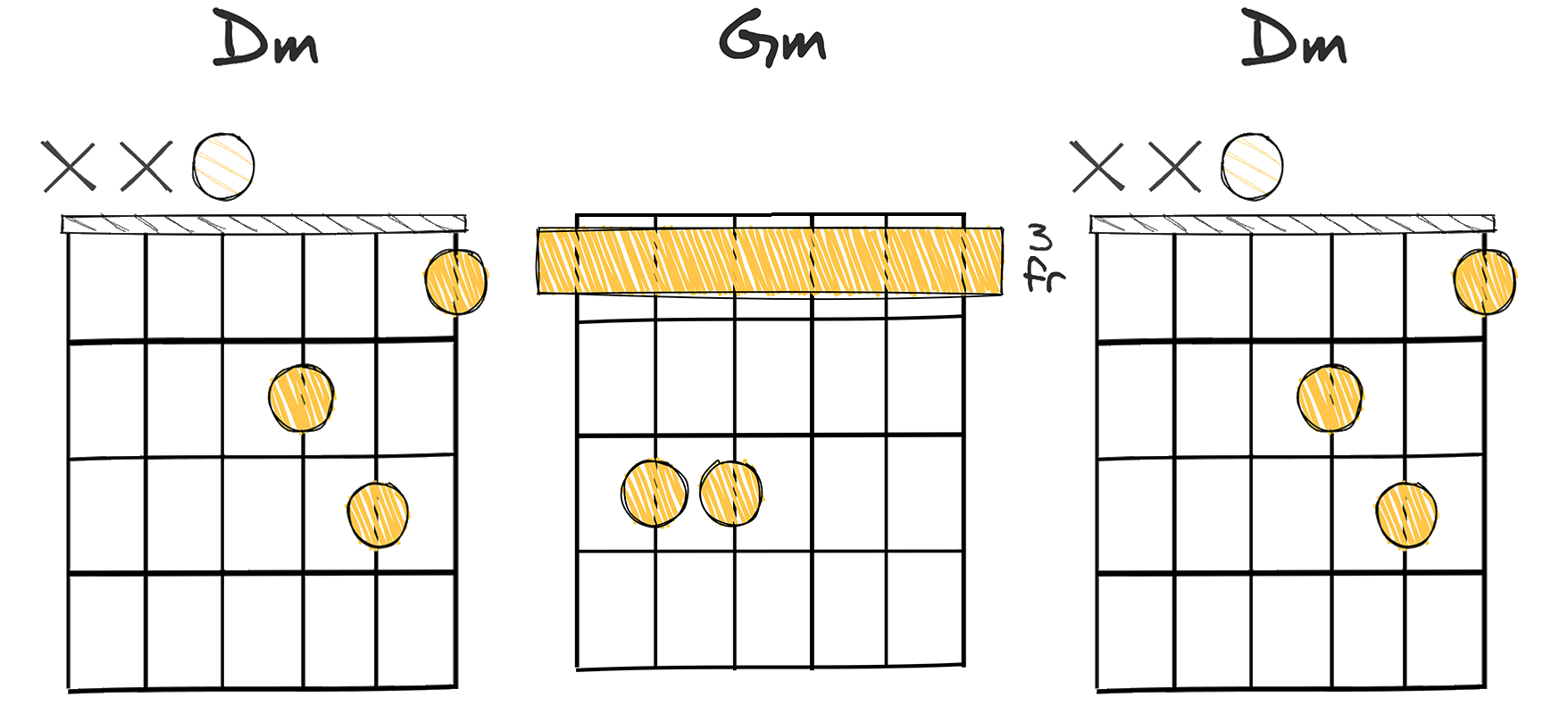
Within Flamenco music, various chord progressions serve as the basis for creating captivating, emotionally resonant pieces.
One such progression we will delve into is i – iv – i (1 – 4 – 1).
The chord progression i – iv – i (1 – 4 – 1) is a simple, yet powerful sequence in Flamenco.
This employs minor chords, which flirt with the notes of the harmonic minor scale, characteristic to Flamenco.
The i – iv – i (1 – 4 – 1) chord progression is a quintessential, textbook example of the use of minor chords in Flamenco, drawing particularly on the unique tonality of the harmonic minor scale.
Using the i – iv – i (1 – 4 – 1) chord progression, Flamenco musicians can conjure a depth of emotion that is both characteristic and unique to the genre.
This progression, often used in the key of D minor as Dm – Gm – Dm, has a remarkable ability to evoke the passion and intensity synonymous with Flamenco.
Yet, while its simplicity is appealing, executing this progression at an intermediate level requires a solid understanding of chord shapes and finger placement.
The i – iv – i (1 – 4 – 1) chord progression has a long-standing history within Flamenco music.
Over the years, many prominent Flamenco guitarists have incorporated this progression into their music, contributing to its rich legacy.
As such, artists who employ this chord progression provide a touch of traditional Flamenco soul to their pieces, whilst allowing space for their individual artistry.
For guitarists hoping to improve their skillset, the i – iv – i (1 – 4 – 1) progression is an interesting one to tackle.
It invites the exploration of elements such as strumming patterns, fingerpicking, and various Flamenco techniques that can challenge and elevate your playing.
By mastering the i – iv – i (1 – 4 – 1) progression, you significantly expand your repertoire and edify your understanding of Flamenco’s core elements.
It is not just about understanding the chords themselves, but also how they interact within the context of Flamenco music.
This nuances are what make learning to play Flamenco guitar a gratifying journey.
Remember, it’s not enough just to memorize chord progressions.
Experiencing the music, feeling the chords, and understanding their interplay is crucial in truly capturing the spirit of Flamenco.
i – bVII – i (1 – flat7 – 1)
A distinctive flamenco progression, creating a dark, passionate sound.
This chord progression typically has a deep, soulful, and rich sound, commonly used in traditional Flamenco music. It involves shifting from the tonic (i) to the flattened seventh (bVII) chord, and then returning to the tonic, providing a dramatic, intense feel typical for Spanish musical style.
- Difficulty: Intermediate
- Example: Am – G – Am (Key of A minor)
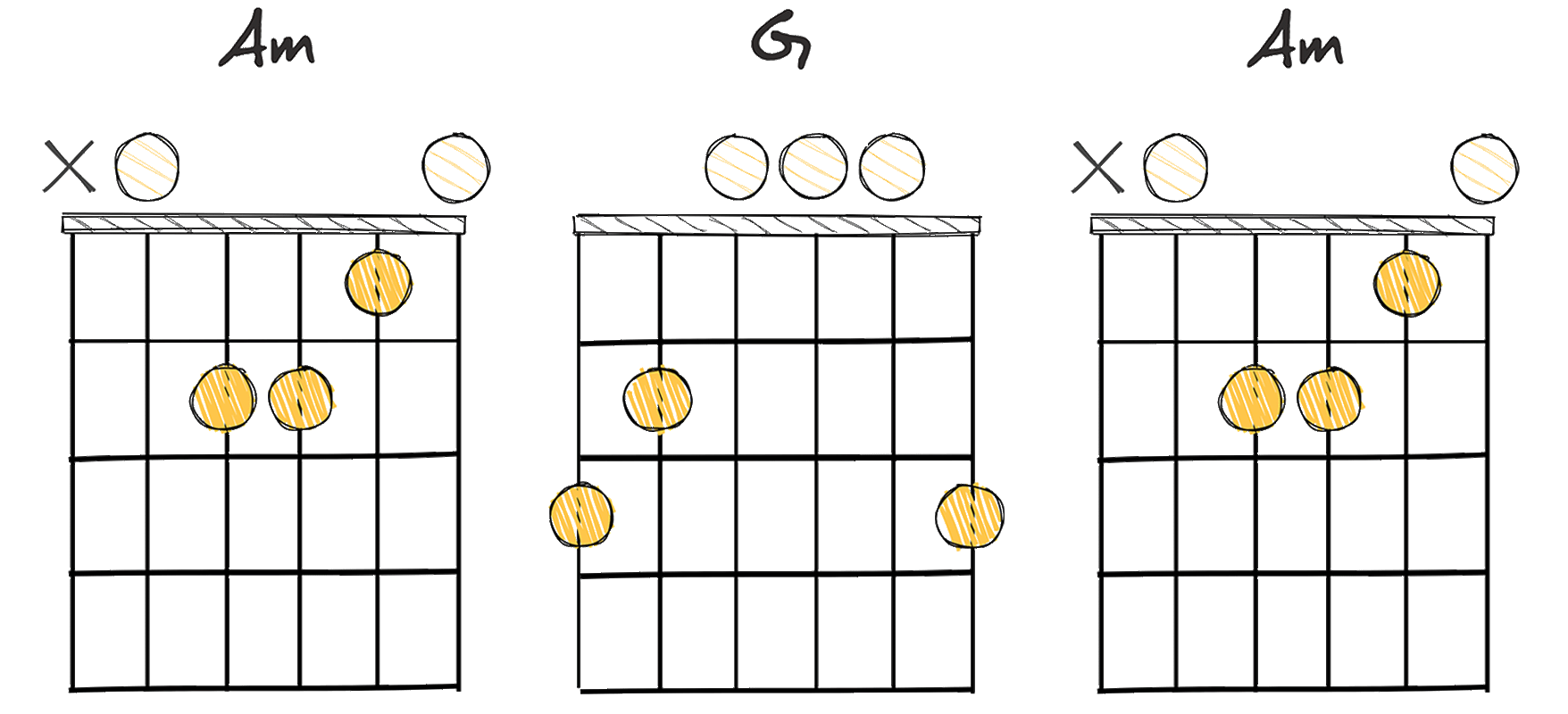
The flamenco music style, originating from Spain, has been greatly appreciated by guitar players worldwide.
Its driving rhythms, evocative melodies, and distinctive chord progressions have influenced musicians across all genres.
One such is the i – bVII – i (1 – flat7 – 1) progression, also shown as Am – G – Am in the key of Am. This progression, intermediate in playing level, features a beautiful, minor, romantic sound that is truly captivating.
The i – bVII – i progression is anchored in the core of traditional flamenco music.
It presents an engaging balance of tension and resolution, creating a dynamic musical dialogue within a simple chord sequence.
The progression’s first chord, the tonic or the ‘i’ chord, acts as the home base, where the piece resolving to provides the piece with a sense of completion.
Then, the piece moves to the ‘bVII’ chord, building an interesting tension that is not quite fully resolved till it moves back to the ‘i’ chord.
The harmony created between the i, bVII and returning to the i chord is what gives this progression its haunting charm and signature flamenco sound.
Indeed, the transition back to the ‘i’ chord offers a lovely resolution and closure; however, its nuanced intrigue lies in the unexpected but pleasing tension created by the ‘bVII’ chord.
The progression forms a circular movement that encourages the listener to anticipate the upcoming chords.
The historical usage of this progression can also be traced back to Andalusian traditional songs, where it was popularly used.
Its unique sound played a key role in shaping the distinctive, vibrant flamenco music style.
The complex rhythm and emotional depth hardwired into the i – bVII – i progression make it an absolutely essential piece for any guitar player looking to delve into flamenco music.
Interestingly enough, you may also find this chord progression in various modern pop and rock songs, further testament to flamenco music’s far-reaching influence.
It’s the minor tonality accentuated by the i – bVII – i progression that makes it universal and appealing to the audience.
For guitarists who are new to playing this progression, it is usually recommended to start learning it in Am (A minor) as it’s a straightforward key on the guitar.
The A minor scale is excellent to start with as it has no sharps or flats, so it’s perfect for those still getting comfortable with the fretboard.
Truly, the i – bVII – i chord progression is a testament to flamenco’s emotive and passionate nature.
Its captivating sound and rhythmic complexity offer an exhilarating challenge for guitarists regardless of their experience level.
Welcome this progression into your practice, and you’ll open doors to the alluring world of flamenco music.
Indeed, with patient practice and continued dedication, any guitarist can master this chord progression and dramatically enhance their musical repertoire.
I – bIII – IV – iii – ii (1 – flat3 – 4 – 3 – 2)
Blends unexpected flair with emotional resonance, creating an exotic dance of tension and resolution.
The I – bIII – IV – iii – ii progression in flamenco music weaves an intriguing aural tapestry. Its unconventional move to the flat3 chord injects an unexpected flair, giving way to an emotionally resonant sequence. The progression creates a dance between tension and resolution, imbuing the music with a captivating and exotic essence.
- Difficulty: Intermediate
- Example: C – Eb – F – Em – Dm (Key of C)

The I – bIII – IV – iii – ii chord progression offers an interesting twist on traditional musical patterns and is uniquely suitable for flamenco music.
This sequence’s intriguing quality is its tonal coloration, enriching the fiery and passionate tones that flamenco music encapsulates.
Historically speaking, while the roots of this progression may not lie directly in classical music, it has found a special place in the realm of flamenco, bringing a modern touch with its harmonic variations.
Within flamenco guitar, this sequence not only contributes a distinctive harmonic flavor but adds a rich sonic texture that resonates with the genre’s essence.
Mastering the I – bIII – IV – iii – ii progression may challenge the novice guitarist but provides a rewarding aural experience, encapsulating the vibrant sounds and complex rhythms typical of flamenco.
Its uniqueness stems from the unexpected movement from the I chord (C major) to the bIII chord (Eb major), followed by a more conventional IV – iii – ii pattern (F major – E minor – D minor), allowing for creative expression.
An example of this progression in the key of C would be: C – Eb- F – Em – Dm.
This combination offers flamenco guitarists an exciting opportunity to play with both chordal and melodic tension, weaving the intricate melodies that define flamenco music.
As a progression that sits between basic and more complicated sequences, it provides a gateway for guitarists to explore new harmonic landscapes without becoming overly complex.
Though the use of the I – bIII – IV – iii – ii progression in flamenco might not be as widespread as other progressions, its use adds a unique flair that’s both fresh and nostalgic.
It allows flamenco guitarists to highlight the genre’s distinctive rhythmic and melodic traits, setting a stage for creativity and exploration.
Additionally, mastery of this progression can lead to further exploration of complex harmonic structures, boosting confidence and skill.
In closing, musical experimentation is at the heart of captivating flamenco music, and the I – bIII – IV – iii – ii progression offers a fascinating blend of tradition and innovation.
Whether a budding guitarist or a seasoned performer, this progression is a valuable component of the flamenco guitarist’s toolkit.
Its vibrant complexity and resonant charm make it a must-try flamenco chord progression that can elevate both practice and performance.
The Bottom Line
Despite the seemingly complex nature of these numerical chords progressions, it remains evident that they form the structural basis for many renowned pieces in music history.
The given sequences, ranging from I – IV – V – I, to iii – VI – ii – V – I, represent a variety of fundamental chord progressions.
Each can evoke distinct emotional responses within the listener and dictate the overall narrative arc of a composition.
With these fundamental progressions at one’s disposal, the potential for creating dynamic and engaging music is near limitless.
It’s clear from this exploration that the expressive power of music is built upon this intricate, yet fundamental framework of chord progression.
Understanding and mastering these foundational structures is undeniably transformative for any budding or professional music composer.
In love with guitars, and gear; expert in all things music! Been writing about guitars for about 5 years and counting. Born in the ’90s. Alma Mater: University of Havana. Always curious, trying to understand the world. #TeamFender




